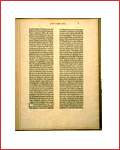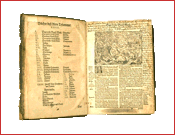 Books
in this period were produced largely for the educated elite of clerics and
scholars. Innovations, including the introduction of paper in the twelfth
century, stimulated the production of works in vernacular languages and made
texts slightly more accessible. Books
in this period were produced largely for the educated elite of clerics and
scholars. Innovations, including the introduction of paper in the twelfth
century, stimulated the production of works in vernacular languages and made
texts slightly more accessible.  But it was the introduction of printing with moveable type that revolutionized
the written word. Printing made it possible to produce an unthinkable number
of seemingly identical copies of texts quickly and cheaply. Not only was the
future of a text secured when printed in multiple copies, the work was also
easily disseminated. Printing satisfied the renaissance's demand for knowledge,
enflamed the popularity of the reformation, and ushered in an age of communication.
The written word would soon become common.
But it was the introduction of printing with moveable type that revolutionized
the written word. Printing made it possible to produce an unthinkable number
of seemingly identical copies of texts quickly and cheaply. Not only was the
future of a text secured when printed in multiple copies, the work was also
easily disseminated. Printing satisfied the renaissance's demand for knowledge,
enflamed the popularity of the reformation, and ushered in an age of communication.
The written word would soon become common. |
